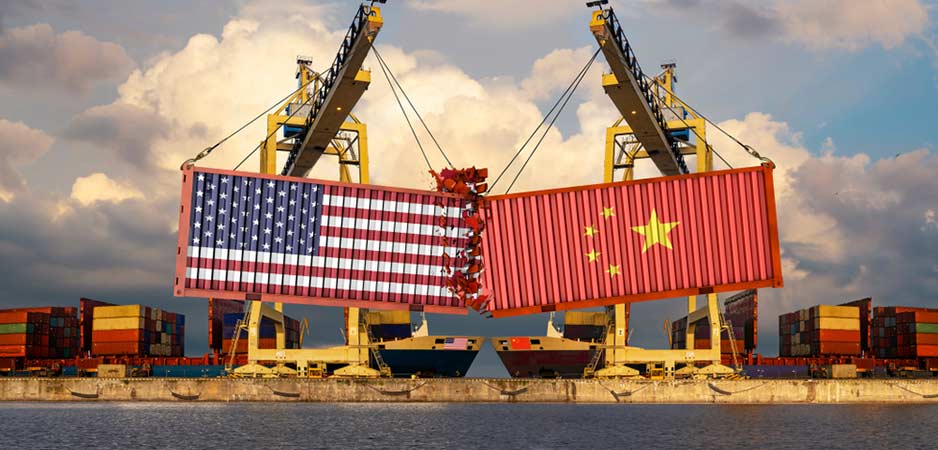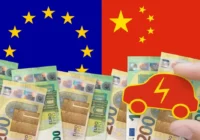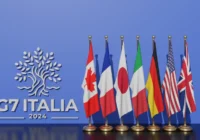Dark times loom for the US economy in the aftermath of President Donald Trump’s latest threat on August 1 to levy 10% tariffs on some $300 billion of imports from China. In response, China allowed the yuan to weaken against the dollar and thereby cushion the impact for Chinese exporters. In a tweet, Trump accused China of “currency manipulation” and called upon on the Federal Reserve to respond.
The yuan-dollar rate of 7-to-1 was at its lowest since 2008. “[The] trade war has now become a currency war, which raises the potential economic harm to another level,” The Wall Street Journal noted in an editorial. On August 5, the Dow Jones and the S&P indices fell 3% and stock markets and currencies in emerging markets weakened, and an economic downturn seemed closer than before. The spread between the 3-month and 10-year Treasury yields — an indicator of recessions — inverted to its widest level since 2007.
On August 1, Trump said the US would impose 10% tariffs on $300 billion worth of imports from China effective September 1, amid signs that talks between the two countries over the past year or so were yielding little progress. That tariff move would be in addition to the higher tariffs already in place for $250 billion worth of imports from China, thereby covering all US imports from that country. Trump reportedly overruled resistance from within his administration in announcing the latest tariff move.
Worries are over the larger and longer-term implications of China allowing the renminbi (RMB) to drop below “the psychological barrier” of 7 to a dollar, said Marshall W. Meyer, Wharton emeritus professor of management. “People are wondering whether China will repeat what it did in 1993-1994 when it devalued the RMB sharply to turn around a recession, and the knock-on effect perhaps was the Asian financial crisis.” Back then, China devalued the yuan by 33% overnight to 8.7 to the dollar as it unified its dual exchange rates, hoping it would help its state-owned enterprises embrace a market-based economy.
The Penn Wharton Budget Model (PWBM), which analyzes the longer-term implications of policy moves, has identified two primary effects of the trade war with China. One is lower output for the US economy, and the other is a shift toward households in the financing of US debt, said Efraim Berkovich, director of computational dynamics at PWBM.
As the escalation in the trade war reduces foreign capital inflows into the US, it would provide a short-term boost to GDP as domestic households would pick up the slack and provide more labor, but GDP will fall the long-run, Berkovich said in an article with Zheli He, an economist at PWBM.
US companies will also see their global competitiveness eroding with the tariff war. “The rest of the world will continue to enjoy lower-priced inputs, and our companies are going to have to compete with them,” said Mary E. Lovely, professor of economics at Syracuse University’s Maxwell School of Citizenship and Public Affairs; she is also a senior fellow at the Peterson Institute for International Affairs. “That really ties one of their hands behind their back. This is doing permanent damage to the US economy.
“It’s [all] pain, no gain,” said Lovely. “For example, we went into this [trade war] ostensibly to get some relief for American corporations in terms of intellectual property rights protection. China hasn’t changed on that yet. What about disciplining their state-owned enterprises? We’re zero on that one.”
Meyer, Berkovich and Lovely discussed the longer-term implications of the trade war with China on the Knowledge@Wharton radio show on SiriusXM.
Impact on Electronics, Farm Produce
The threatened tariff increases “will fall much more heavily than in previous rounds on consumer goods, clothes, shoes and baby products,” said Lovely. “Almost half of it will fall on computers and electronic devices, because of the way our trade with China is structured.”
Lovely predicted “a big hit” to prices of cell phones, laptops and anything electronic, affecting businesses, households and universities. The consequences could be worse if Trump persists and takes the next round of tariffs from the proposed 10% to 25%, she added.
China has also suspended purchases of US agricultural products, and an official statement through its state-run media outlet Xinhua said it is up to the US to set right trade conditions. “We stand to lose all of what was a $9.1 billion market in 2018, which was down sharply from the $19.5 billion U.S. farmers exported to China in 2017,” said American Farm Bureau Federation President Zippy Duvall.
“The consequence is the entire economic system becomes less efficient; that is the long-term cost to all of us,” said Meyer.
US Debt Will Grow
Of the two likely outcomes of the tariff war Berkovich identified, the implications for the financing of the US debt is more significant in the long run. Thus far, trade with China has helped finance US debt, and a reduction in the volume of that trade means others have to pick up the tab. “When we shut down the trade channel by which dollars are sent out to broaden and come back as purchases of assets, we are actually forcing the debt in the US to grow,” he said. “We’re forcing US households to buy the debt, and that’s going to long term drive the economy down.”
According to Berkovich, “Right now, 40 cents out of every new dollar that’s issued is purchased by foreigners. That is quite substantial, and you’re being subsidized to that level now. Otherwise, you and I would have to buy it.” As the trade war escalates, “the Chinese are going to hoard their dollars,” he added.
Foreign Capital Inflows Will Fall
A decrease in US imports resulting from higher tariffs reduces foreign investment flows into the US, Berkovich said, attributing that to a phenomenon he called “effective openness.” “As the average tariff rates rises, the openness goes down,” he noted. “And that means less capital flowing in, and less purchases of US debt by foreigners.”
Berkovich explained that when US households pay for imports with dollars, foreign exporters typically use that to buy US exports or dollar-denominated assets. But “effective openness” of the US to such foreign investments is reduced because they would tend to invest in their home countries, even at the expense of forgoing higher returns elsewhere. He called that a “home bias,” a concept identified by Martin Feldstein and Charles Horioka in 1979 paper.
“Even a country with relatively few laws that directly limit the flow of capital may not be fully effectively open due to various non-legal frictions on capital flows, including a preference to invest in one’s own country,” Berkovich and He wrote in their article.
The reduced foreign investment will also hurt the U.S. labor market, Berkovich warned. “You are going to see that wages are going to drop. With purchasing power and wages lower, we’re not in a good place.”
Even if the trade war ends, the U.S. will be in a worse place than now, Berkovich predicted. “When foreign capital actually starts flooding back in, we will be in a situation where foreigners own a greater share of U.S. capital than they did prior to the trade war.”
Berkovich and He elaborated on that in a blog post. “Although a trade war initially lowers the share of U.S. capital owned by foreigners, it will actually increase the amount of American business capital owned by foreigners, by almost $1 trillion by 2028,” they wrote. “Over time, the foreign-owned share of business capital rises from about 29% today to over 34% in 2049.”
Brace for Permanently Higher Costs
The US tariff move would also upset existing global supply chains by forcing both countries to look for alternative sources for their imports. While the US may not be selling soybeans to China now, Brazil and Canada will continue to export agricultural products to China, Meyer said. “But guess what? We may be selling soybeans to Brazil or to Canada. Our farmers are getting a lower price for it. The middlemen are extracting a tax, to work around the tariffs.”
Lovely warned that an escalating trade war with China will mean US households must brace for higher prices that won’t come down. “We’re going to see permanently higher prices because the system as a whole will be less efficient,” she said. “President Trump’s actions are cementing firms’ view that this is going to go on for a long time.”
Already, US importers are moving away from sourcing from China and increasing their investments in other countries, Lovely noted. “But the fact is, that other place is a higher cost option, and [that’s] the reason we weren’t using it in the first place,” she pointed out. “And that becomes a permanent tax on US firms and US consumers, reducing the consumer’s buying power and reducing American firms competitiveness on the global market.”
In addition to a readjustment in global supply chains, the trade war would drive US importers to prepare by stockpiling, said Berkovich. “The natural thing for you to do if you think that the economy is going down the toilet is that you want to prepare,” he said. “It’s like a squirrel before winter hoarding the nuts. The longer you drag out the trade war, the more nuts you start to hoard.”
Finding a Way Out
Politics is behind the tariffs, and the two countries are on “a collision course” on that front, Meyer noted. Within the US, there appears to be bipartisan consensus on a tough approach to China. However, the US seems to be playing right into the hands of Chinese President Xi Jinping with its tariff moves, he said. “Xi Jinping has effectively had his position bolstered by what appears to be peremptory US action on tariffs.”
At the same time, the US is trying to find a better foothold in Asia and in Europe, where it may have antagonized some of its allies not just with the China tariffs, but also by “repudiating” some of its multilateral agreements, Meyer continued. In the process, the US seems to have lost more ground than has gained, and needs to “rethink this very, very carefully.”
As the US seems set to end up losing more than it set out to gain from the trade war, it needs to urgently do some course correction, according to Meyer. “We are on the horns of a terrific dilemma here,” he said. “Unless the US takes some action at this point,” China will extend its economy to the Belt and Road Initiative and other initiatives such as its Made in China 2025 program, which will further reduce US influence in world trade, he added. “The consequence is the entire economic system becomes less efficient; that is the long-term cost to all of us,” said Meyer.
Faced with those headwinds, the US has to focus on what it wants to achieve in the long run, Meyer said. “What is our vision of the future? What’s the role of the US economy in the global economy 10, 15 or 20 years from now? Until we have answers, we’re stuck with tariffs or other defensive moves.”
*[This article was originally published by Knowledge@Wharton, a partner institution of Fair Observer.]
The views expressed in this article are the author’s own and do not necessarily reflect Fair Observer’s editorial policy.
Support Fair Observer
We rely on your support for our independence, diversity and quality.
For more than 10 years, Fair Observer has been free, fair and independent. No billionaire owns us, no advertisers control us. We are a reader-supported nonprofit. Unlike many other publications, we keep our content free for readers regardless of where they live or whether they can afford to pay. We have no paywalls and no ads.
In the post-truth era of fake news, echo chambers and filter bubbles, we publish a plurality of perspectives from around the world. Anyone can publish with us, but everyone goes through a rigorous editorial process. So, you get fact-checked, well-reasoned content instead of noise.
We publish 2,500+ voices from 90+ countries. We also conduct education and training programs
on subjects ranging from digital media and journalism to writing and critical thinking. This
doesn’t come cheap. Servers, editors, trainers and web developers cost
money.
Please consider supporting us on a regular basis as a recurring donor or a
sustaining member.
Will you support FO’s journalism?
We rely on your support for our independence, diversity and quality.






